Our church tours have in recent years have usually been blessed with fine weather but on this occasion, 12th June 2024, the afternoon was overcast and gloomy. Nevertheless, 56 members enjoyed looking at three churches just north of West Malling.
The church of St Peter & St Paul, Trottiscliffe is part of an exquisitely pretty group, which also includes Court Lodge and a row of cottages, beneath the scarp of the North Downs. Few churches in Kent are so beautifully sited. Church and village are half a mile apart, a common occurrence in the County. The fabric of the church is unremarkable: it is a small, 12thcentury building of flint, the date indicated by a few surviving windows and tufa quoins. The chancel is, however, unusually long and the south tower, a Perpendicular addition, is asymmetrically placed – another Kentish characteristic.

Trotticliffe: church and manor house looking north
The interior is crowded with 18th century furniture, much of it from Westminster Abbey. The outstanding piece is the magnificent pulpit, designed for the choir of the Abbey by Henry Keene in 1775. It has a mixture of Gothic and classical decoration and a tester – with superb intarsia on the underside – which is supported by a palm tree. The structure, far too big for this location, was brought here in 1824. Other furniture probably from Westminster is the reredos and reliefs attached to it, the fine altar rails and the wooden boss which decorates the font cover. Fixed to the altar rails is a tiny offertory box for donations by women being ‘churched’.
The explanation for these furnishings having come to such an obscure church is that for much of the 18th and early 19thcenturies the Bishops of Rochester were also Deans of Westminster. Meopham and Shoreham churches have furnishings from the same source.
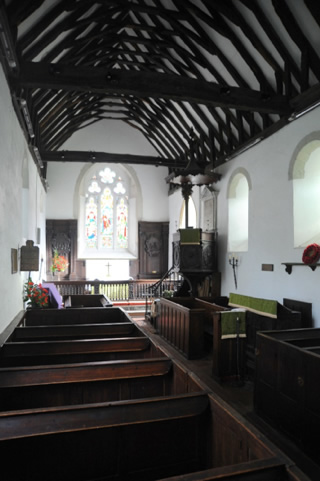
Trottiscliffe: interior looking east
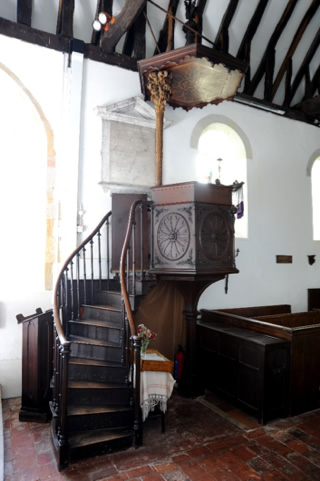
Pulpit
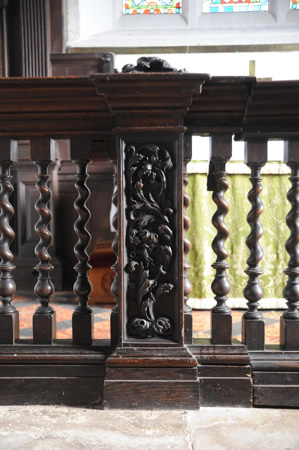
Altar rail
Ward and Hughes. The celebrated artist Graham Sutherland is buried in the churchyard, under a yew tree just north-east of the chancel.
St Martin, Ryarsh is again away from its village and surrounded by fields. From the south it looks a pretty, late Perpendicular building of ragstone: tower, with good details, south aisle and porch. John Newman convincingly suggests that the tower west window, which is of an early Perpendicular pattern, may have been re-set when the tower was built against the west wall: and it is worth noting that many churches were formerly towerless and only acquired their towers during the late medieval mania for building such structures.
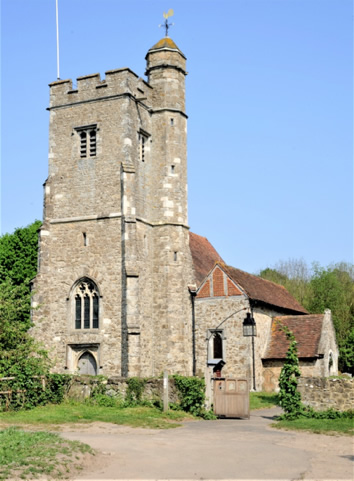
Ryarsh church seen from the west
As so often in Kent, the Perpendicular exterior masks an older structure, partly early Norman and partly 14th century. The north wall of both nave and chancel survive from an early Norman church, each with a 12th century window. Outside there is herringbone masonry and tufa quoins, both signs of an early date. The chancel east wall has traces of three Norman windows, two below and one above. The chancel arch and nave south arcade are of the early 14thcentury.
The fittings mostly date from the restoration of 1871 and are not of much interest. The exceptions are a Norman pillar piscina in the chancel – a great rarity; the late medieval south door; a Jacobean pulpit and good glass by Clayton and Bell.
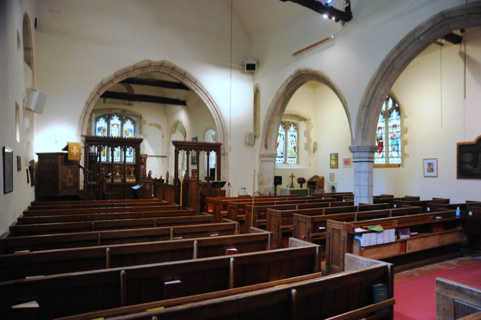
Ryarsh: the interior looking east
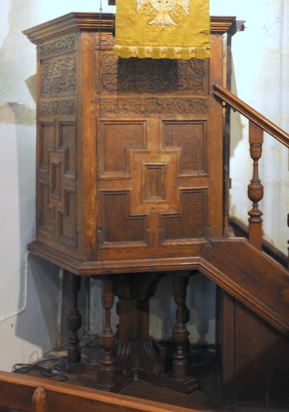
Pulpit
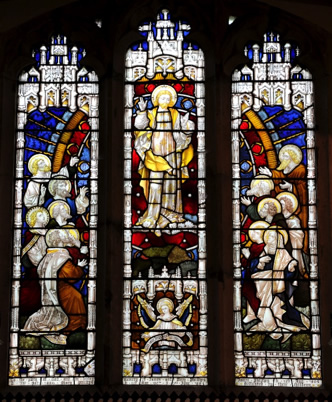
East window by Clayton & Bell
St Margaret, Addington stands amongst trees on a large mound, this time close to the village and approached up a short avenue. The body of the church is early Norman, as at Ryarsh, built of the local ironstone with tufa quoins, There is some herringbone masonry to attest to the early date. The tower, south chapel and porch are all 15th century additions. The tower is very similar to that at Ryarsh, including especially the details of the arch towards the nave. The chapel and porch can be dated from wills to 1463 and 1474 respectively. The latter has very pretty, original bargeboards.
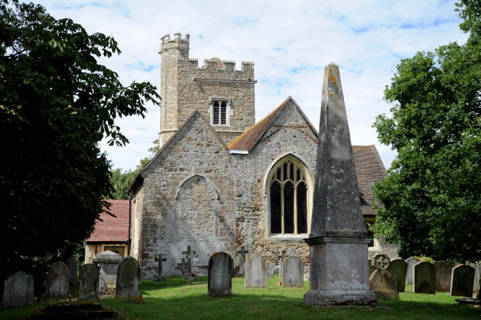
Addington church seen from the east, showing Locker monument
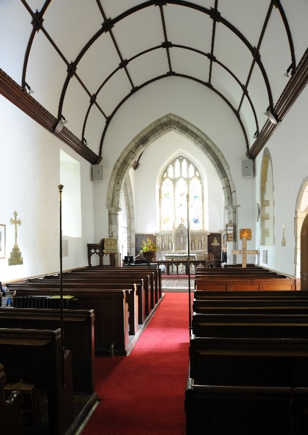
Interior looking east
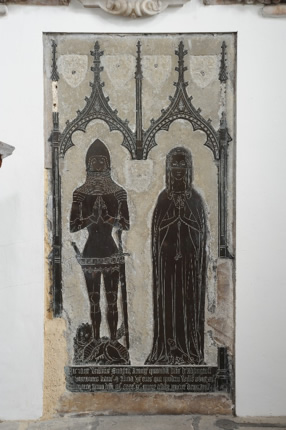
Brass to William Snayth +1409
The furnishings are all Victorian and unremarkable, though there is some good Victorian glass. But there is a fine array of brasses, especially those to two 15th century knights and their ladies in the south chapel, one of the knights wearing armour of amazing ornateness which must have been intended for fashionable display, not for battle. The highpoint of the church is, however, the spectacular wall monument of alabaster in the same chapel to William Watton, who died in 1651. The sculptor was Joshua Marshall.
East of the church is a monument in the form of a tall obelisk to Lucy Locker, who died in 1780. She was the wife of Commodore William Locker. Nelson sailed as a young lieutenant with Locker and attributed to him all that he knew about the art of seamanship. Willam died in 1800 and is buried in the family vault within the church. Nelson attended his funeral at Addington.
The church has a fine community room and kitchen in an extension erected on the south side of the nave about 15 years ago. There we given an excellent tea.
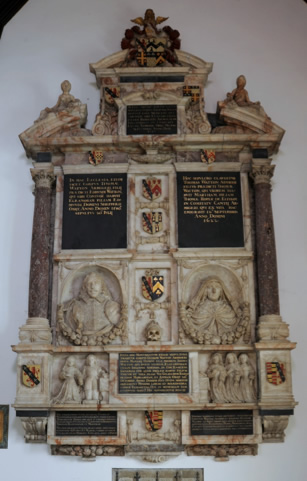
Addington: monument to William Watton +1651
The church was rather heavily restored in 1856. From that date are the north chapel, much of the window tracery and the roofs of the nave and chancel. The boarded and painted roof of the south chapel, however, dates from 1651.
The furnishings are all Victorian and unremarkable, though there is some good Victorian glass. But there is a fine array of brasses, especially those to two 15th century knights and their ladies in the south chapel, one of the knights wearing armour of amazing ornateness which must have been intended for fashionable display, not for battle. The highpoint of the church is, however, the spectacular wall monument of alabaster in the same chapel to William Watton, who died in 1651. The sculptor was Joshua Marshall.
East of the church is a monument in the form of a tall obelisk to Lucy Locker, who died in 1780. She was the wife of Commodore William Locker. Nelson sailed as a young lieutenant with Locker and attributed to him all that he knew about the art of seamanship. Willam died in 1800 and is buried in the family vault within the church. Nelson attended his funeral at Addington.
The church has a fine community room and kitchen in an extension erected on the south side of the nave about 15 years ago. There we given an excellent tea.

